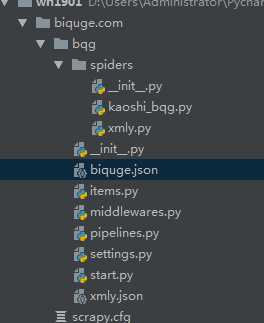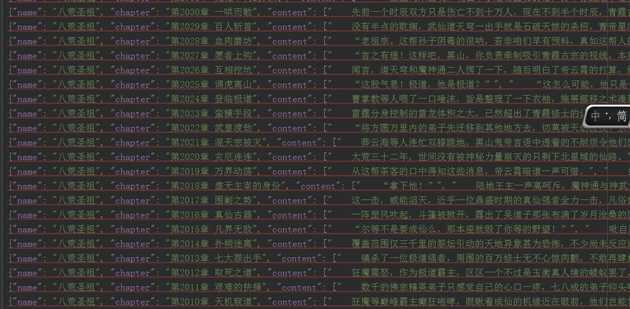python_scrapy_爬虫
2020-12-13 06:29
标签:init pat obj isp on() 开始 play elf ini python , scrapy框架入门 , xpath解析, json 存储. 涉及到详情页爬取, 目录结构: kaoshi_bqg.py item.py pipelines.py starts.py 然后是爬取到的数据 biquge.json xmly.json python_scrapy_爬虫 标签:init pat obj isp on() 开始 play elf ini 原文地址:https://www.cnblogs.com/longpy/p/11180956.html


import scrapy
from scrapy.spiders import Rule
from scrapy.linkextractors import LinkExtractor
from ..items import BookBQGItem
class KaoshiBqgSpider(scrapy.Spider):
name = ‘kaoshi_bqg‘
allowed_domains = [‘biquge5200.cc‘]
start_urls = [‘https://www.biquge5200.cc/xuanhuanxiaoshuo/‘]
rules = (
# 编写匹配文章列表的规则
Rule(LinkExtractor(allow=r‘https://www.biquge5200.cc/xuanhuanxiaoshuo/‘), follow=True),
# 匹配文章详情
Rule(LinkExtractor(allow=r‘.+/[0-9]{1-3}_[0-9]{2-6}/‘), callback=‘parse_item‘, follow=False),
)
# 小书书名
def parse(self, response):
a_list = response.xpath(‘//*[@id="newscontent"]/div[1]/ul//li//span[1]/a‘)
for li in a_list:
name = li.xpath(".//text()").get()
detail_url = li.xpath(".//@href").get()
yield scrapy.Request(url=detail_url, callback=self.parse_book, meta={‘info‘: name})
# 单本书所有的章节名
def parse_book(self, response):
name = response.meta.get(‘info‘)
list_a = response.xpath(‘//*[@id="list"]/dl/dd[position()>20]//a‘)
for li in list_a:
chapter = li.xpath(".//text()").get()
url = li.xpath(".//@href").get()
yield scrapy.Request(url=url, callback=self.parse_content, meta={‘info‘: (name, chapter)})
# 每章节内容
def parse_content(self, response):
name, chapter = response.meta.get(‘info‘)
content = response.xpath(‘//*[@id="content"]//p/text()‘).getall()
item = BookBQGItem(name=name, chapter=chapter, content=content)
yield item
 代码
代码


from scrapy.exporters import JsonLinesItemExporter
class BqgPipeline(object):
def __init__(self):
self.fp = open("biquge.json", ‘wb‘)
# JsonLinesItemExporter 调度器
self.exporter = JsonLinesItemExporter(self.fp, ensure_ascii=False)
def process_item(self, item, spider):
self.exporter.export_item(item)
return item
def close_item(self):
self.fp.close()
print("爬虫结束")
# class XmlyPipeline(object):
# def __init__(self):
# self.fp = open("xmly.json", ‘wb‘)
# # JsonLinesItemExporter 调度器
# self.exporter = JsonLinesItemExporter(self.fp, ensure_ascii=False)
#
# def process_item(self, item, spider):
# self.exporter.export_item(item)
# return item
#
# def close_item(self):
# self.fp.close()
# print("爬虫结束")


from scrapy import cmdline
cmdline.execute("scrapy crawl kaoshi_bqg".split())
# cmdline.execute("scrapy crawl xmly".split())



meta属性,可以用来保持多个请求之间的数据连接。url:这个request对象发送请求的url。callback:在下载器下载完相应的数据后执行的回调函数。
上一篇:windows7所有版本迅雷地址下载集合(含32位和64位) - imsoft.cnblogs
下一篇:Test: 为WLW添加源代码着色插件WindowsLiveWriter.CNBlogs.CodeHighlighter